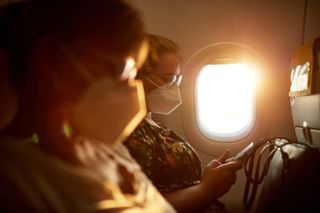Leaving middle seat empty lowers COVID-19 spread on planes, modeling suggests
Unfortunately, airlines have already started filling those seats.

It's not just about elbow room anymore: Leaving middle seats empty may reduce COVID-19 spread on airplanes, a new modeling study finds.
The study, conducted by researchers at the Centers for Disease Control and Prevention (CDC) and Kansas State University, was carried out at a time when few flights included blocked-off middle seats. In the United States, only Delta continues to leave middle seats empty, and the airline has announced that the practice will continue only until April 30.
The CDC recommends against nonessential air travel for those unvaccinated for COVID-19.
Related: 11 sometimes deadly diseases that hopped across species
The newly released study has roots going back to 2017, when Kansas State University researchers set up mock airliner cabins filled with body-temperature mannequins to simulate viral spread in an airplane — a project that was, at the time, relevant to influenza research. The researchers spritzed the fake cabins' air with the virus MS2, an RNA virus that attacks certain bacteria but which is harmless to humans. The virus is often used as a stand-in for dangerous pathogens that spread in tiny, floating aerosols, as COVID-19 does.
Using the data from those experiments, which simulated both single-aisle and double-aisle cabins, the researchers created a computer model to analyse the reduction of exposure to the SAR-CoV-2 with distance from an infected person. They also simulated what the exposure would be if middle seats were left empty or allowed to be full.
Depending on the scenario used, the results showed an exposure reduction of between 23% and 57% when middle seats were left empty instead of filled.
Sign up for the Live Science daily newsletter now
Get the world’s most fascinating discoveries delivered straight to your inbox.
The 23% reduction occurred when an infectious passenger was seated in the same row as an uninfected passenger. Leaving a middle seat between the two reduced the likelihood that the uninfected passenger would be exposed to the virus by nearly a quarter.
The researchers also modeled the risk reduction for an entire 120-person cabin when one, two or three people on the plane were infectious with SARS-CoV-2 and middle seats were left empty. They found that depending on how many people were infectious, leaving middle seats empty reduced the risk of onward exposure by 35% to 39.4%.
Of course, blocking off middle seats in the real world reduces the number of potentially infectious people on the plane by up to 33% in and of itself, assuming the plane would otherwise be full. To prevent that capacity reduction from skewing the distancing results, the researchers placed infectious passengers only in aisle or middle seats in this model. Thus, the exposure reduction was related specifically to the empty seats, not to fewer passengers overall.
Finally, the researchers tested a scenario in which nine infectious passengers were scattered between three full rows, versus a scenario in which middle seats were left empty and there were six infectious passengers among 12 total in three rows. This scenario measured the combined effects of distance and capacity reduction. The results showed a 57% reduction in exposure to the virus with empty middle seats. (Exposure, the researchers note, is not the same as transmitting an actual infection, but exposure is a prerequisite for viral spread.)
Despite the feeling that getting on an airplane means sharing air with more than 100 potentially infectious strangers, airline ventilation systems actually collect and filter air over sections of a few rows, meaning that passengers really only share most of their air with the people seated nearby. The finding that distance matters echoes real-world data on airplane outbreaks, which have shown that being closer to the infectious person is associated with more risk of becoming infected.
Because the original data in the cabin mock-ups was collected before the COVID-19 pandemic, the researchers did not examine the effect of face masks on the viral spread. Masks are good at blocking large respiratory droplets, which don't travel far before falling, and they also help prevent fomite transmission by keeping people's hands away from their noses and mouths. They block smaller aerosols, as well, the researchers wrote, but less efficiently. Thus, the combination of empty middle seats and face masks is likely to be more protective than face masks alone.
The researchers published the study Wednesday (April 14) in the CDC's Morbidity and Mortality Weekly Report.
Originally published on Live Science.

Stephanie Pappas is a contributing writer for Live Science, covering topics ranging from geoscience to archaeology to the human brain and behavior. She was previously a senior writer for Live Science but is now a freelancer based in Denver, Colorado, and regularly contributes to Scientific American and The Monitor, the monthly magazine of the American Psychological Association. Stephanie received a bachelor's degree in psychology from the University of South Carolina and a graduate certificate in science communication from the University of California, Santa Cruz.
Most Popular

